Characterizing the Soil Microbial Community Associated with the Fungal Pathogen Coccidioides immitis
Abstract
1. Introduction
2. Materials and Methods
2.1. Soil Collection
2.2. Soil DNA Extraction
2.3. Quantitative PCR to Detect Coccidioides spp.
2.4. ITS2 and 16S Amplicon Sequencing
2.5. Amplicon Sequence Processing
2.6. Statistical Analyses
3. Results
3.1. Alpha Diversity
3.2. Beta Diversity
3.3. Co-Occurrence Analysis
4. Discussion
4.1. The Soil Microhabitat Drives Patterns in Microbial Diversity
4.2. Coccidioides Presence Is Associated with Higher Microbial Diversity in Soils
5. Conclusions
Supplementary Materials
Author Contributions
Funding
Institutional Review Board Statement
Informed Consent Statement
Data Availability Statement
Acknowledgments
Conflicts of Interest
References
- Nguyen, C.; Barker, B.M.; Hoover, S.; Nix, D.E.; Ampel, N.M.; Frelinger, J.A.; Orbach, M.J.; Galgiani, J.N. Recent Advances in Our Understanding of the Environmental, Epidemiological, Immunological, and Clinical Dimensions of Coccidioidomycosis. Clin. Microbiol. Rev. 2013, 26, 505–525. [Google Scholar] [CrossRef] [PubMed]
- WHO Fungal Priority Pathogens List to Guide Research, Development and Public Health Action; World Health Organization: Geneva, Switzerland, 2022.
- Fisher, M.C.; Alastruey-Izquierdo, A.; Berman, J.; Bicanic, T.; Bignell, E.M.; Bowyer, P.; Bromley, M.; Brüggemann, R.; Garber, G.; Cornely, O.A.; et al. Tackling the Emerging Threat of Antifungal Resistance to Human Health. Nat. Rev. Microbiol. 2022, 20, 557–571. [Google Scholar] [CrossRef]
- Head, J.R.; Sondermeyer-Cooksey, G.; Heaney, A.K.; Yu, A.T.; Jones, I.; Bhattachan, A.; Campo, S.K.; Wagner, R.; Mgbara, W.; Phillips, S.; et al. Effects of Precipitation, Heat, and Drought on Incidence and Expansion of Coccidioidomycosis in Western USA: A Longitudinal Surveillance Study. Lancet Planet. Health 2022, 6, e793–e803. [Google Scholar] [CrossRef] [PubMed]
- Heaney, A.K.; Camponuri, S.K.; Head, J.R.; Collender, P.; Weaver, A.; Sondermeyer Cooksey, G.; Yu, A.; Vugia, D.; Jain, S.; Bhattachan, A.; et al. Coccidioidomycosis Seasonality in California: A Longitudinal Surveillance Study of the Climate Determinants and Spatiotemporal Variability of Seasonal Dynamics, 2000–2021. Lancet Reg. Health Am. 2024, 38, 100864. [Google Scholar] [CrossRef] [PubMed]
- Kolivras, K.N.; Comrie, A.C. Modeling Valley Fever (Coccidioidomycosis) Incidence on the Basis of Climate Conditions. Int. J. Biometeorol. 2003, 47, 87–101. [Google Scholar] [CrossRef]
- Swatek, F.E. Ecology of Coccidioides Immitis. Mycopathol. Mycol. Appl. 1970, 41, 3–12. [Google Scholar] [CrossRef]
- Gade, L.; McCotter, O.Z.; Bowers, J.R.; Waddell, V.; Brady, S.; Carvajal, J.A.; Sunenshine, R.; Komatsu, K.K.; Engelthaler, D.M.; Chiller, T.; et al. The Detection of Coccidioides from Ambient Air in Phoenix, Arizona: Evidence of Uneven Distribution and Seasonality. Med. Mycol. 2020, 58, 552–559. [Google Scholar] [CrossRef]
- Lewis, E.R.G.; Bowers, J.R.; Barker, B.M. Dust Devil: The Life and Times of the Fungus That Causes Valley Fever. PLoS Pathog. 2015, 11, e1004762. [Google Scholar] [CrossRef]
- Taylor, J.W.; Barker, B.M. The Endozoan, Small-Mammal Reservoir Hypothesis and the Life Cycle of Coccidioides Species. Med. Mycol. 2019, 57, S16–S20. [Google Scholar] [CrossRef]
- Chow, N.A.; Kangiser, D.; Gade, L.; McCotter, O.Z.; Hurst, S.; Salamone, A.; Wohrle, R.; Clifford, W.; Kim, S.; Salah, Z.; et al. Factors Influencing Distribution of Coccidioides Immitis in Soil, Washington State, 2016. mSphere 2021, 6, e00598-21. [Google Scholar] [CrossRef]
- Flynn, N.M.; Hoeprich, P.D.; Kawachi, M.M.; Lee, K.K.; Lawrence, R.M.; Goldstein, E.; Jordan, G.W.; Kundargi, R.S.; Wong, G.A. An Unusual Outbreak of Windborne Coccidioidomycosis. N. Engl. J. Med. 1979, 301, 358–361. [Google Scholar] [CrossRef] [PubMed]
- Kollath, D.R.; Miller, K.J.; Barker, B.M. The Mysterious Desert Dwellers: Coccidioides immitis and Coccidioides posadasii, Causative Fungal Agents of Coccidioidomycosis. Virulence 2019, 10, 222–233. [Google Scholar] [CrossRef] [PubMed]
- Smith, C.E.; Beard, R.R. Varieties of Coccidioidal Infection in Relation to the Epidemiology and Control of the Diseases. Am. J. Public Health Nations Health 1946, 36, 1394–1402. [Google Scholar] [CrossRef] [PubMed]
- Barker, B.M.; Litvintseva, A.P.; Riquelme, M.; Vargas-Gastélum, L. Coccidioides Ecology and Genomics. Med. Mycol. 2019, 57, S21–S29. [Google Scholar] [CrossRef]
- Freedman, M.; Jackson, B.R.; McCotter, O.; Benedict, K. Coccidioidomycosis Outbreaks, United States and Worldwide, 1940–2015. Emerg. Infect. Dis. 2018, 24, 417–424. [Google Scholar] [CrossRef]
- Loofbourow, J.C.; Pappagianis, D.; Cooper, T.Y. Endemic Coccidioidomycosis in Northern California—An Outbreak in Yolo County. Calif. Med. 1969, 111, 5–9. [Google Scholar]
- Sondermeyer Cooksey, G.L.; Wilken, J.A.; McNary, J.; Gilliss, D.; Shusterman, D.; Materna, B.L.; Vugia, D.J. Dust Exposure and Coccidioidomycosis Prevention Among Solar Power Farm Construction Workers in California. Am. J. Public Health 2017, 107, 1296–1303. [Google Scholar] [CrossRef]
- Werner, S.B.; Pappagianis, D.; Heindl, I.; Mickel, A. An Epidemic of Coccidioidomycosis among Archeology Students in Northern California. N. Engl. J. Med. 1972, 286, 507–512. [Google Scholar] [CrossRef]
- Wilken, J.A.; Sondermeyer, G.; Shusterman, D.; McNary, J.; Vugia, D.J.; McDowell, A.; Borenstein, P.; Gilliss, D.; Ancock, B.; Prudhomme, J.; et al. Coccidioidomycosis among Workers Constructing Solar Power Farms, California, USA, 2011–2014. Emerg. Infect. Dis. 2015, 21, 1997–2005. [Google Scholar] [CrossRef]
- Barker, B.M.; Tabor, J.A.; Shubitz, L.F.; Perrill, R.; Orbach, M.J. Detection and Phylogenetic Analysis of Coccidioides Posadasii in Arizona Soil Samples. Fungal Ecol. 2012, 5, 163–176. [Google Scholar] [CrossRef]
- Bowers, J.R.; Parise, K.L.; Kelley, E.J.; Lemmer, D.; Schupp, J.M.; Driebe, E.M.; Engelthaler, D.M.; Keim, P.; Barker, B.M. Direct Detection of Coccidioides from Arizona Soils Using CocciENV, a Highly Sensitive and Specific Real-Time PCR Assay. Med. Mycol. 2019, 57, 246–255. [Google Scholar] [CrossRef] [PubMed]
- del Rocío Reyes-Montes, M.; Pérez-Huitrón, M.A.; Ocaña-Monroy, J.L.; Frías-De-León, M.G.; Martínez-Herrera, E.; Arenas, R.; Duarte-Escalante, E. The Habitat of Coccidioides Spp. and the Role of Animals as Reservoirs and Disseminators in Nature. BMC Infect. Dis. 2016, 16, 550. [Google Scholar] [CrossRef]
- Kollath, D.R.; Teixeira, M.M.; Funke, A.; Miller, K.J.; Barker, B.M. Investigating the Role of Animal Burrows on the Ecology and Distribution of Coccidioides Spp. in Arizona Soils. Mycopathologia 2020, 185, 145–159. [Google Scholar] [CrossRef] [PubMed]
- Head, J.R.; Camponuri, S.K.; Weaver, A.K.; Montoya, L.; Lee, E.; Radosevich, M.T.; Jones, I.; Wagner, R.; Bhattachan, A.; Campbell, G.; et al. Small Mammals and Their Burrows Shape the Distribution of Coccidioides in Soils: A Long-Term Ecological Experiment. bioRxiv 2024, preprint. [Google Scholar]
- Chan, Y.-K.; McCormick, W.A.; Seifert, K.A. Characterization of an Antifungal Soil Bacterium and Its Antagonistic Activities against Fusarium Species. Can. J. Microbiol. 2003, 49, 253–262. [Google Scholar] [CrossRef] [PubMed]
- Petatán-Sagahón, I.; Anducho-Reyes, M.A.; Silva-Rojas, H.V.; Arana-Cuenca, A.; Tellez-Jurado, A.; Cárdenas-Álvarez, I.O.; Mercado-Flores, Y. Isolation of Bacteria with Antifungal Activity against the Phytopathogenic Fungi Stenocarpella Maydis and Stenocarpella Macrospora. Int. J. Mol. Sci. 2011, 12, 5522–5537. [Google Scholar] [CrossRef]
- Kollath, D.R.; Morales, M.M.; Itogawa, A.N.; Mullaney, D.; Lee, N.R.; Barker, B.M. Combating the Dust Devil: Utilizing Naturally Occurring Soil Microbes in Arizona to Inhibit the Growth of Coccidioides Spp., the Causative Agent of Valley Fever. J. Fungi 2023, 9, 345. [Google Scholar] [CrossRef]
- Lauer, A.; Baal, J.; Mendes, S.; Casimiro, K.; Passaglia, A.; Valenzuela, A.; Guibert, G. Valley Fever on the Rise—Searching for Microbial Antagonists to the Fungal Pathogen Coccidioides Immitis. Microorganisms 2019, 7, 31. [Google Scholar] [CrossRef]
- Egeberg, R.O.; Elconin, A.E.; Egeberg, M.C. Effect of Salinity and Temperature on Coccidioides Immitis and Three Antagonistic Soil Saprophytes. J. Bacteriol. 1964, 88, 473–476. [Google Scholar] [CrossRef]
- Alvarado, P.; Teixeira, M.D.; Andrews, L.; Fernandez, A.; Santander, G.; Doyle, A.; Perez, M.; Yegres, F.; Barker, B.M. Detection of Coccidioides Posadasii from Xerophytic Environments in Venezuela Reveals Risk of Naturally Acquired Coccidioidomycosis Infections. Emerg. Microbes Infect. 2018, 7, 1–13. [Google Scholar] [CrossRef]
- Wagner, R.; Montoya, L.; Head, J.R.; Campo, S.; Remais, J.; Taylor, J.W. Coccidioides Undetected in Soils from Agricultural Land and Uncorrelated with Time or the Greater Soil Fungal Community on Undeveloped Land. PLoS Pathog. 2023, 19, e1011391. [Google Scholar] [CrossRef] [PubMed]
- Lauer, A.; Lopez, J.J.; Chabolla, M.; Kloock, C. Risk of Exposure to Coccidioides Spp. in the Temblor Special Recreation Management Area (SRMA), Kern County, CA. Microorganisms 2023, 11, 518. [Google Scholar] [CrossRef]
- Prugh, L.R.; Brashares, J.S. Partitioning the Effects of an Ecosystem Engineer: Kangaroo Rats Control Community Structure via Multiple Pathways. J. Anim. Ecol. 2012, 81, 667–678. [Google Scholar] [CrossRef] [PubMed]
- Prugh, L.R.; Deguines, N.; Grinath, J.B.; Suding, K.N.; Bean, W.T.; Stafford, R.; Brashares, J.S. Ecological Winners and Losers of Extreme Drought in California. Nat. Clim. Change 2018, 8, 819–824. [Google Scholar] [CrossRef]
- Friedman, L.; Smith, C.E.; Pappagianis, D.; Berman, R.J. Survival of Coccidioides Immitis Under Controlled Conditions of Temperature and Humidity. Am. J. Public Health Nations Health 1956, 46, 1317–1324. [Google Scholar] [CrossRef]
- Greene, D.R.; Koenig, G.; Fisher, M.C.; Taylor, J.W. Soil Isolation and Molecular Identification of Coccidioides immitis. Mycologia 2000, 92, 406–410. [Google Scholar] [CrossRef]
- Pulido-Chavez, M.F.; Randolph, J.W.J.; Glassman, S.I. Not All Is Lost: Resilience of Microbiome Samples to Freezer Failures and Long-Term Storage. mSphere 2024, 10, e00603-24. [Google Scholar] [CrossRef]
- Rubin, B.E.R.; Gibbons, S.M.; Kennedy, S.; Hampton-Marcell, J.; Owens, S.; Gilbert, J.A. Investigating the Impact of Storage Conditions on Microbial Community Composition in Soil Samples. PLoS ONE 2013, 8, e70460. [Google Scholar] [CrossRef]
- Edwards, J.D.; Love, S.J.; Phillips, R.P.; Fei, S.; Domke, G.; Parker, J.D.; McCormick, M.; LaRue, E.A.; Schweitzer, J.A.; Bailey, J.K.; et al. Long- and Short-Term Soil Storage Methods Other than Freezing Can Be Useful for DNA-Based Microbial Community Analysis. Soil Biol. Biochem. 2024, 191, 109329. [Google Scholar] [CrossRef]
- Brandt, F.B.; Breidenbach, B.; Brenzinger, K.; Conrad, R. Impact of Short-Term Storage Temperature on Determination of Microbial Community Composition and Abundance in Aerated Forest Soil and Anoxic Pond Sediment Samples. Syst. Appl. Microbiol. 2014, 37, 570–577. [Google Scholar] [CrossRef]
- Lauber, C.L.; Zhou, N.; Gordon, J.I.; Knight, R.; Fierer, N. Effect of Storage Conditions on the Assessment of Bacterial Community Structure in Soil and Human-Associated Samples: Influence of Short-Term Storage Conditions on Microbiota. FEMS Microbiol. Lett. 2010, 307, 80–86. [Google Scholar] [CrossRef]
- Saubolle, M.A.; Wojack, B.R.; Wertheimer, A.M.; Fuayagem, A.Z.; Young, S.; Koeneman, B.A. Multicenter Clinical Validation of a Cartridge-Based Real-Time PCR System for Detection of Coccidioides Spp. in Lower Respiratory Specimens. J. Clin. Microbiol. 2018, 56, e01277-17. [Google Scholar] [CrossRef] [PubMed]
- Bruns, T.D.; White, T.J.; Taylor, J.W. Fungal Molecular Systematics. Annu. Rev. Ecol. Evol. Syst. 1991, 22, 525–564. [Google Scholar] [CrossRef]
- Schoch, C.L.; Seifert, K.A.; Huhndorf, S.; Robert, V.; Spouge, J.L.; Levesque, C.A.; Chen, W.; Fungal Barcoding Consortium; Fungal Barcoding Consortium Author List; Bolchacova, E.; et al. Nuclear Ribosomal Internal Transcribed Spacer (ITS) Region as a Universal DNA Barcode Marker for Fungi. Proc. Natl. Acad. Sci. USA 2012, 109, 6241–6246. [Google Scholar] [CrossRef]
- White, T.J.; Bruns, T.; Lee, S.J.W.T.; Taylor, J. Amplification and Direct Sequencing of Fungal Ribosomal RNA Genes for Phylogenetics. In PCR Protocols: A Guide to Methods and Applications; Academic Press: Oxford, UK, 1990; pp. 315–322. ISBN 978-0-12-372180-8. [Google Scholar]
- Lane, D.J.; Pace, B.; Olsen, G.J.; Stahl, D.A.; Sogin, M.L.; Pace, N.R. Rapid Determination of 16S Ribosomal RNA Sequences for Phylogenetic Analyses. Proc. Natl. Acad. Sci. USA 1985, 82, 6955–6959. [Google Scholar] [CrossRef] [PubMed]
- Taylor, D.L.; Walters, W.A.; Lennon, N.J.; Bochicchio, J.; Krohn, A.; Caporaso, J.G.; Pennanen, T. Accurate Estimation of Fungal Diversity and Abundance through Improved Lineage-Specific Primers Optimized for Illumina Amplicon Sequencing. Appl. Environ. Microbiol. 2016, 82, 7217–7226. [Google Scholar] [CrossRef]
- Gao, C.; Montoya, L.; Xu, L.; Madera, M.; Hollingsworth, J.; Purdom, E.; Hutmacher, R.B.; Dahlberg, J.A.; Coleman-Derr, D.; Lemaux, P.G.; et al. Strong Succession in Arbuscular Mycorrhizal Fungal Communities. ISME J. 2019, 13, 214–226. [Google Scholar] [CrossRef]
- Simmons, T.; Caddell, D.F.; Deng, S.; Coleman-Derr, D. Exploring the Root Microbiome: Extracting Bacterial Community Data from the Soil, Rhizosphere, and Root Endosphere. J. Vis. Exp. 2018, 135, 57561. [Google Scholar] [CrossRef]
- Bolyen, E.; Rideout, J.R.; Dillon, M.R.; Bokulich, N.A.; Abnet, C.C.; Al-Ghalith, G.A.; Alexander, H.; Alm, E.J.; Arumugam, M.; Asnicar, F.; et al. Reproducible, Interactive, Scalable and Extensible Microbiome Data Science Using QIIME 2. Nat. Biotechnol. 2019, 37, 852–857. [Google Scholar] [CrossRef]
- Martin, M. Cutadapt Removes Adapter Sequences from High-Throughput Sequencing Reads. EMBnet J. 2011, 17, 10. [Google Scholar] [CrossRef]
- Callahan, B.J.; McMurdie, P.J.; Rosen, M.J.; Han, A.W.; Johnson, A.J.A.; Holmes, S.P. DADA2: High-Resolution Sample Inference from Illumina Amplicon Data. Nat. Methods 2016, 13, 581–583. [Google Scholar] [CrossRef] [PubMed]
- Abarenkov, K.; Nilsson, R.H.; Larsson, K.-H.; Taylor, A.F.S.; May, T.W.; Frøslev, T.G.; Pawlowska, J.; Lindahl, B.; Põldmaa, K.; Truong, C.; et al. The UNITE database for molecular identification and taxonomic communication of fungi and other eukaryotes: Sequences, taxa and classifications reconsidered. Nucleic Acids Res. 2023, 52, D791–D797. [Google Scholar] [CrossRef]
- Abarenkov, K.; Zirk, A.; Piirmann, T.; Pöhönen, R.; Ivanov, F.; Nilsson, R.H.; Kõljalg, U. UNITE QIIME Release for Fungi. Version 10.05.2021. UNITE Community. 2021. Available online: https://doi.org/10.15156/BIO/1264708 (accessed on 21 June 2023).
- Quast, C.; Pruesse, E.; Yilmaz, P.; Gerken, J.; Schweer, T.; Yarza, P.; Peplies, J.; Glöckner, F.O. The SILVA Ribosomal RNA Gene Database Project: Improved Data Processing and Web-Based Tools. Nucleic Acids Res. 2012, 41, D590–D596. [Google Scholar] [CrossRef] [PubMed]
- Shannon, C.E. A Mathematical Theory of Communication. Bell Syst. Tech. J. 1948, 27, 379–423. [Google Scholar] [CrossRef]
- Bray, J.R.; Curtis, J.T. An Ordination of the Upland Forest Communities of Southern Wisconsin. Ecol. Monogr. 1957, 27, 326–349. [Google Scholar] [CrossRef]
- Stone, L.; Roberts, A. The Checkerboard Score and Species Distributions. Oecologia 1990, 85, 74–79. [Google Scholar] [CrossRef]
- McMurdie, P.J.; Holmes, S. Phyloseq: An R Package for Reproducible Interactive Analysis and Graphics of Microbiome Census Data. PLoS ONE 2013, 8, e61217. [Google Scholar] [CrossRef] [PubMed]
- Oksanen, J.; Simpson, G.; Blanchet, F.G.; Kindt, R.; Legendre, P.; Minchin, P.; O’Hara, R.B.; Solymos, P.; Stevens, M.H.; Szoecs, E.; et al. Vegan: Community Ecology Package 2022. Available online: https://CRAN.R-project.org/package=vegan (accessed on 25 April 2024).
- Cáceres, M.D.; Legendre, P. Associations between Species and Groups of Sites: Indices and Statistical Inference. Ecology 2009, 90, 3566–3574. [Google Scholar] [CrossRef]
- Benjamini, Y.; Hochberg, Y. Controlling the False Discovery Rate: A Practical and Powerful Approach to Multiple Testing. J. R. Stat. Soc. Ser. B Methodol. 1995, 57, 289–300. [Google Scholar] [CrossRef]
- Broennimann, O.; Cola, V.D.; Petitpierre, B.; Breiner, F.; Scherrer, D.; D’Amen, M.; Randin, C.; Engler, R.; Hordijk, W.; Mod, H.; et al. Ecospat: Spatial Ecology Miscellaneous Methods 2023. Available online: https://cran.r-project.org/web/packages/ecospat/index.html (accessed on 9 April 2024).
- Hawkins, L.K. Burrows of Kangaroo Rats Are Hotspots for Desert Soil Fungi. J. Arid Environ. 1996, 32, 239–249. [Google Scholar] [CrossRef]
- Kuznetsova, T.A.; Kam, M.; Khokhlova, I.S.; Kostina, N.V.; Dobrovolskaya, T.G.; Umarov, M.M.; Degen, A.A.; Shenbrot, G.I.; Krasnov, B.R. Desert Gerbils Affect Bacterial Composition of Soil. Microb. Ecol. 2013, 66, 940–949. [Google Scholar] [CrossRef] [PubMed]
- Powell, J.T.; Chatziefthimiou, A.D.; Banack, S.A.; Cox, P.A.; Metcalf, J.S. Desert Crust Microorganisms, Their Environment, and Human Health. J. Arid Environ. 2015, 112, 127–133. [Google Scholar] [CrossRef]
- Šumbera, R.; Chitaukali, W.N.; Elichová, M.; Kubová, J.; Burda, H. Microclimatic Stability in Burrows of an Afrotropical Solitary Bathyergid Rodent, the Silvery Mole-Rat (Heliophobius Argenteocinereus). J. Zool. 2004, 263, 409–416. [Google Scholar] [CrossRef]
- Grinnell, J. The Burrowing Rodents of California as Agents in Soil Formation. J. Mammal. 1923, 4, 137–149. [Google Scholar] [CrossRef]
- Platt, B.F.; Kolb, D.J.; Kunhardt, C.G.; Milo, S.P.; New, L.G. Burrowing Through the Literature: The Impact of Soil-Disturbing Vertebrates on Physical and Chemical Properties of Soil. Soil Sci. 2016, 181, 175. [Google Scholar] [CrossRef]
- Dang, H.; Zhao, W.; Zhang, T.; Cheng, Y.; Dong, J.; Zhuang, L. Great Gerbil Burrowing-Induced Microbial Diversity Shapes the Rhizosphere Soil Microenvironments of Haloxylon ammodendron in Temperate Deserts. Front. Microbiol. 2022, 13, 960594. [Google Scholar] [CrossRef]
- Kaufmann, C.; Cassin-Sackett, L. Fine-Scale Spatial Structure of Soil Microbial Communities in Burrows of a Keystone Rodent Following Mass Mortality. Front. Ecol. Evol. 2021, 9, 758348. [Google Scholar] [CrossRef]
- Longland, W.S.; Dimitri, L.A. Kangaroo Rats: Ecosystem Engineers on Western Rangelands. Rangelands 2021, 43, 72–80. [Google Scholar] [CrossRef]
- Tappe, D.T. Natural History of the Tulare Kangaroo Rat. J. Mammal. 1941, 22, 117. [Google Scholar] [CrossRef]
- Canals, R.M.; Herman, D.J.; Firestone, M.K. How Disturbance by Fossorial Mammals Alters N Cycling in a California Annual Grassland. Ecology 2003, 84, 875–881. [Google Scholar] [CrossRef]
- Mirbod-Donovan, F.; Schaller, R.; Hung, C.-Y.; Xue, J.; Reichard, U.; Cole, G.T. Urease Produced by Coccidioides Posadasii Contributes to the Virulence of This Respiratory Pathogen. Infect. Immun. 2006, 74, 504–515. [Google Scholar] [CrossRef] [PubMed][Green Version]
- Bauer, M.A.; Kainz, K.; Carmona-Gutierrez, D.; Madeo, F. Microbial Wars: Competition in Ecological Niches and within the Microbiome. Microb. Cell 2018, 5, 215–219. [Google Scholar] [CrossRef]
- Sharpton, T.J.; Stajich, J.E.; Rounsley, S.D.; Gardner, M.J.; Wortman, J.R.; Jordar, V.S.; Maiti, R.; Kodira, C.D.; Neafsey, D.E.; Zeng, Q.; et al. Comparative Genomic Analyses of the Human Fungal Pathogens Coccidioides and Their Relatives. Genome Res. 2009, 19, 1722–1731. [Google Scholar] [CrossRef]
- Desjardins, C.A.; Champion, M.D.; Holder, J.W.; Muszewska, A.; Goldberg, J.; Bailão, A.M.; Brigido, M.M.; da Silva Ferreira, M.E.; Garcia, A.M.; Grynberg, M.; et al. Comparative Genomic Analysis of Human Fungal Pathogens Causing Paracoccidioidomycosis. PLoS Genet. 2011, 7, e1002345. [Google Scholar] [CrossRef] [PubMed]
- Whiston, E.; Taylor, J.W. Comparative Phylogenomics of Pathogenic and Nonpathogenic Species. G3 GenesGenomesGenetics 2015, 6, 235–244. [Google Scholar] [CrossRef] [PubMed]
- Newton, R.J.; Jones, S.E.; Helmus, M.R.; McMahon, K.D. Phylogenetic Ecology of the Freshwater Actinobacteria acI Lineage. Appl. Environ. Microbiol. 2007, 73, 7169–7176. [Google Scholar] [CrossRef]
- Horner-Devine, M.C.; Bohannan, B.J.M. Phylogenetic Clustering and Overdispersion in Bacterial Communities. Ecology 2006, 87, S100–S108. [Google Scholar] [CrossRef]
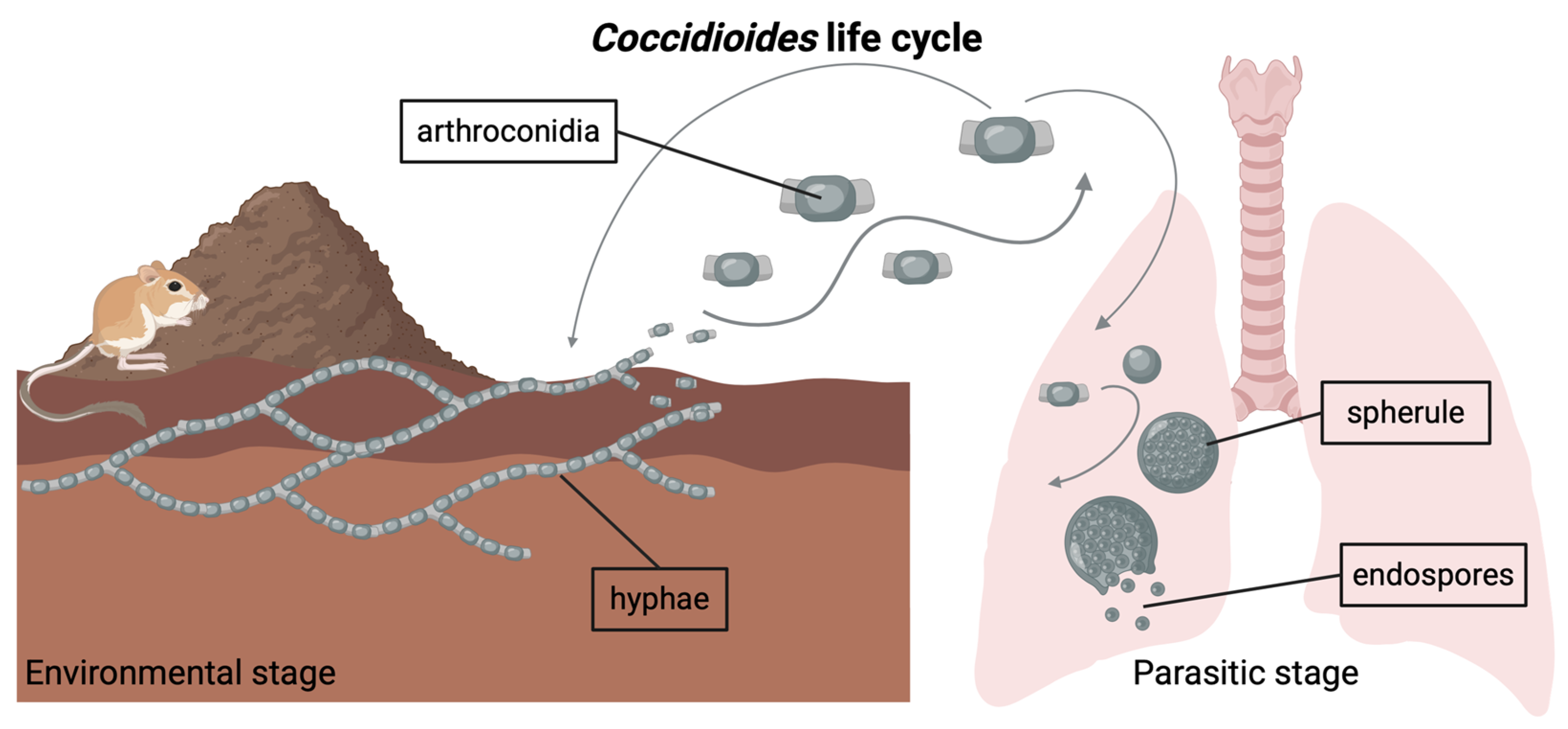
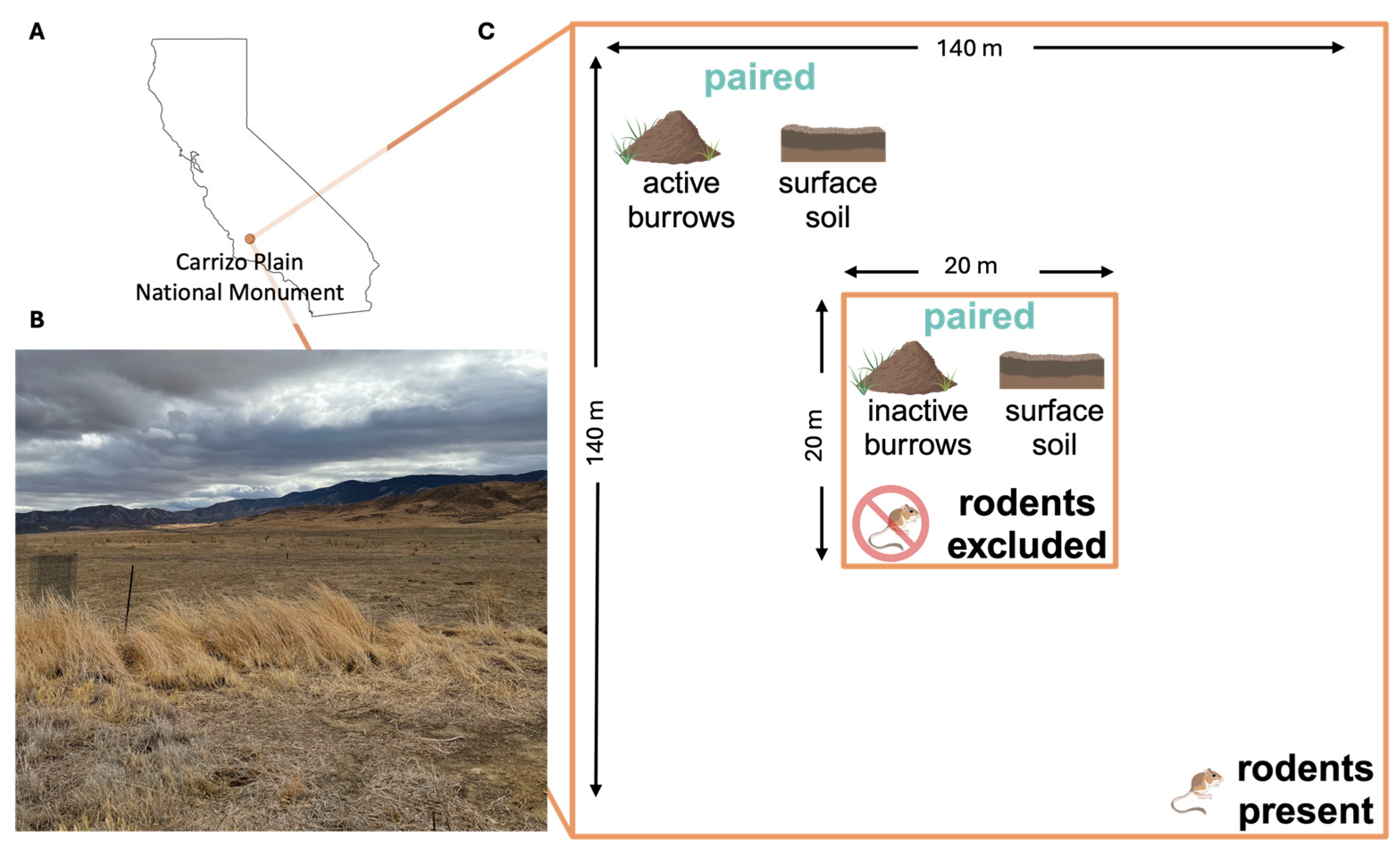
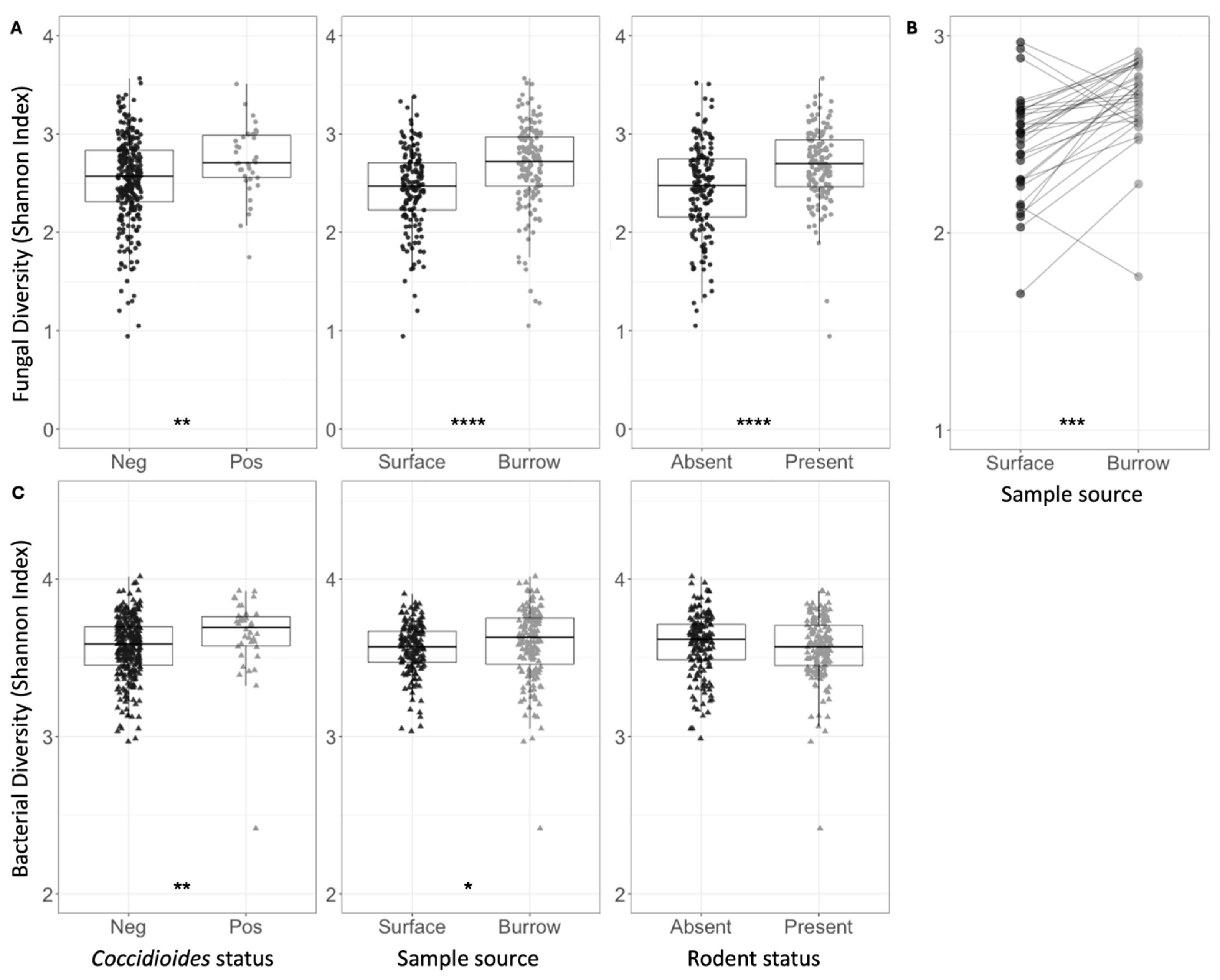

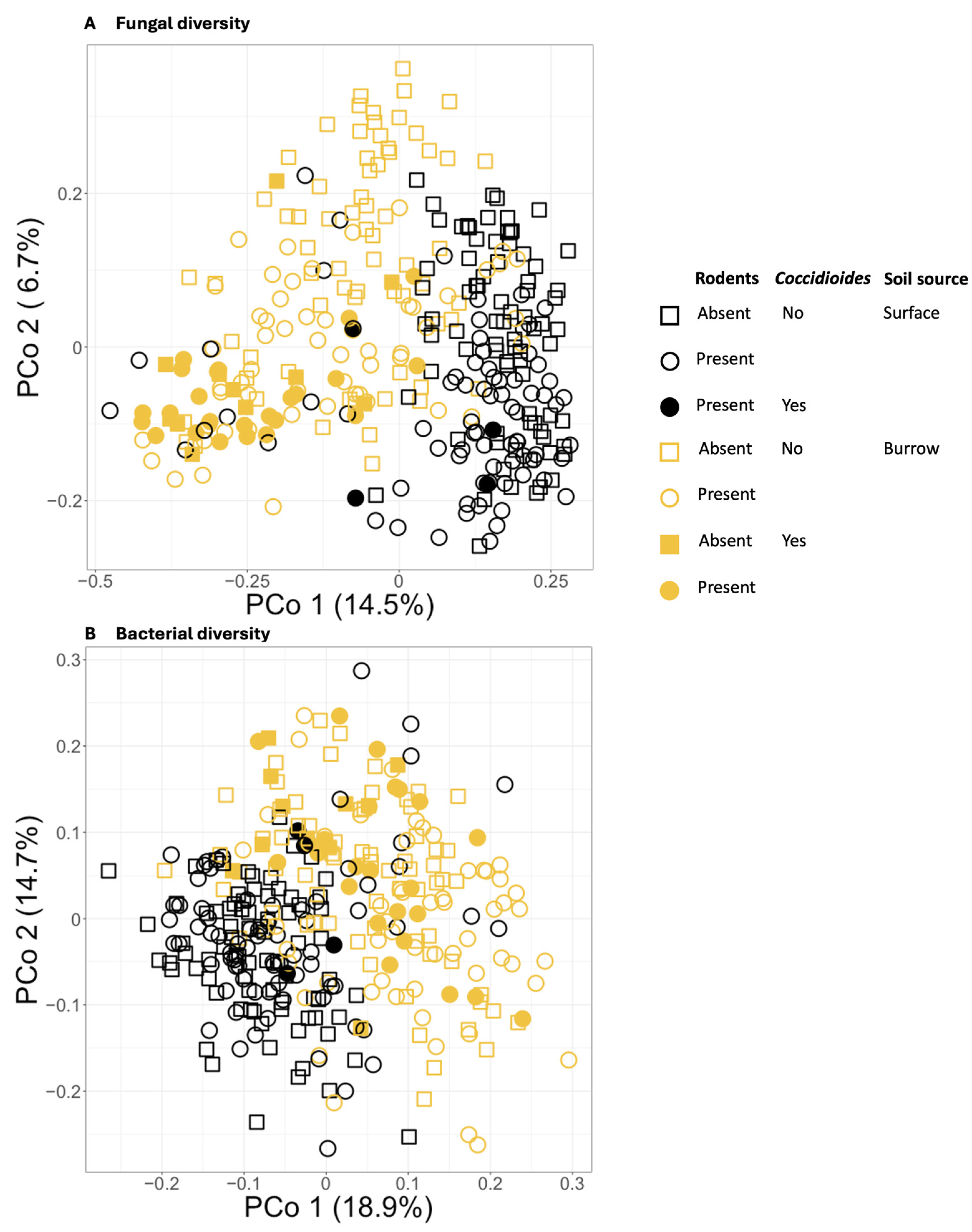
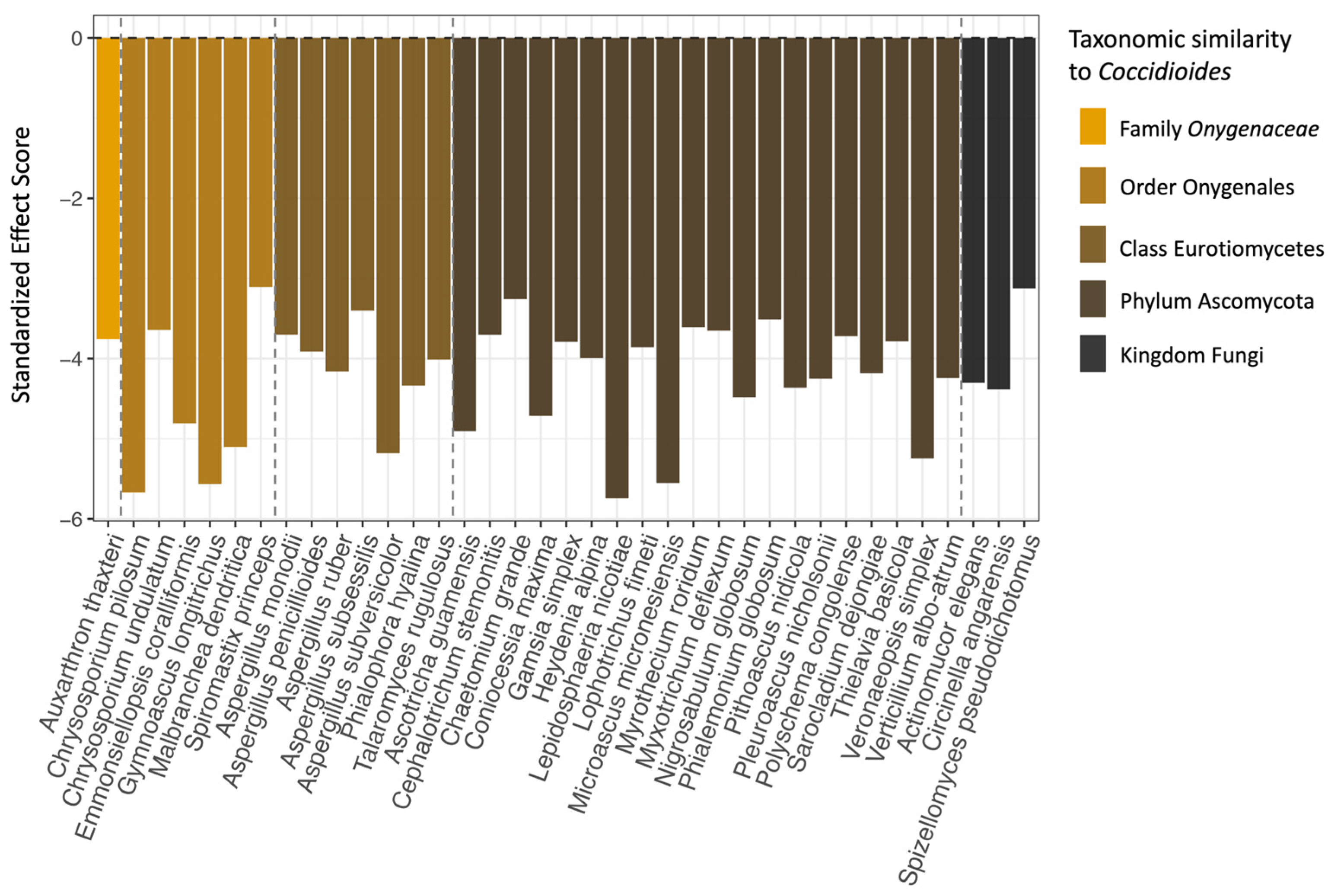
| Richness Mean (Q1, Q3) | Evenness Mean (Q1, Q3) | Shannon Mean (Q1, Q3) | |
|---|---|---|---|
| Overall (n = 318) | 65.84 (51.25, 80.0) | 0.62 (0.57, 0.67) | 2.56 (2.34, 2.85) |
| Grazed pasture (n = 158) | 67.32 (54.00, 83.25) | 0.60 (0.56, 0.66) | 2.53 (2.34, 2.81) |
| Ungrazed pasture (n = 160) | 64.38 (49.75, 79) | 0.63 (0.58, 0.68) | 2.59 (2.33, 2.88) |
| Burrow (n = 159) | 76.94 (64.50, 89.00) | 0.62 (0.58, 0.67) | 2.67 (2.47, 2.97) |
| Surface (n = 159) | 54.74 (46.00, 61.50) | 0.61 (0.56, 0.67) | 2.44 (2.23, 2.71) |
| Rodents absent (n = 159) | 61.26 (48.50, 71.00) | 0.59 (0.54, 0.66) | 2.44 (2.16, 2.75) |
| Rodents present (n = 159) | 70.42 (54.00, 86.00) | 0.64 (0.60, 0.68) | 2.68 (2.46, 2.94) |
| Coccidioides-positive (n = 38) | 81.58 (69.75, 92.25) | 0.62 (0.58, 0.67) | 2.73 (2.56, 2.99) |
| Coccidioides-negative (n = 280) | 63.70 (50.00, 75.25) | 0.61 (0.57, 0.67) | 2.54 (2.31, 2.83) |
| Burrow (n = 159) | |||
| Coccidioides-positive (n = 34) | 83.88 (78.25, 93.00) | 0.62 (0.57, 0.67) | 2.73 (2.54, 2.99) |
| Rodents absent (n = 11) | 83.09 (79.00, 86.50) | 0.62 (0.57, 0.68) | 2.75 (2.60, 2.98) |
| Rodents present (n = 23) | 84.26 (78.50, 93.50) | 0.62 (0.58, 0.67) | 2.72 (2.53, 2.98) |
| Coccidioides-negative (n = 125) | 75.06 (62.00, 88.00) | 0.62 (0.58, 0.67) | 2.66 (2.42, 2.96) |
| Rodents absent (n = 68) | 69.60 (59.75, 79.50) | 0.61 (0.57, 0.66) | 2.57 (2.38, 2.85) |
| Rodents present (n = 57) | 81.56 (72.00, 94.00) | 0.63 (0.60, 0.68) | 2.77 (2.56, 3.02) |
| Richness Mean (Q1, Q3) | Evenness Mean (Q1, Q3) | Shannon Mean (Q1, Q3) | |
|---|---|---|---|
| Overall (n = 318) | 137.12 (128.00, 150.00) | 0.73 (0.71, 0.75) | 3.57 (3.47, 3.71) |
| Grazed pasture (n = 158) | 137.06 (128.00, 150.00) | 0.73 (0.71, 0.75) | 3.57 (3.47, 3.70) |
| Ungrazed pasture (n = 160) | 137.18 (128.00, 148.25) | 0.73 (0.71, 0.75) | 3.58 (3.48, 3.72) |
| Burrow (n = 159) | 137.38 (128.50, 150.00) | 0.73 (0.71, 0.75) | 3.59 (3.46, 3.75) |
| Surface (n = 159) | 136.86 (128.00, 149.00) | 0.72 (0.71, 0.74) | 3.56 (3.47, 3.67) |
| Rodents absent (n = 159) | 137.36 (128.00, 150.00) | 0.73 (0.71, 0.75) | 3.59 (3.49, 3.71) |
| Rodents present (n = 159) | 136.89 (128.50, 148.00) | 0.73 (0.71, 0.75) | 3.56 (3.45, 3.71) |
| Coccidioides-positive (n = 38) | 141.68 (130.25, 159.50) | 0.74 (0.72, 0.76) | 3.64 (3.58, 3.76) |
| Coccidioides-negative (n = 280) | 136.50 (128.00, 149.00) | 0.73 (0.71, 0.75) | 3.57 (3.45, 3.70) |
Disclaimer/Publisher’s Note: The statements, opinions and data contained in all publications are solely those of the individual author(s) and contributor(s) and not of MDPI and/or the editor(s). MDPI and/or the editor(s) disclaim responsibility for any injury to people or property resulting from any ideas, methods, instructions or products referred to in the content. |
© 2025 by the authors. Licensee MDPI, Basel, Switzerland. This article is an open access article distributed under the terms and conditions of the Creative Commons Attribution (CC BY) license (https://creativecommons.org/licenses/by/4.0/).
Share and Cite
Radosevich, M.; Head, J.; Couper, L.; Weaver, A.; Camponuri, S.; Montoya, L.; Taylor, J.W.; Remais, J. Characterizing the Soil Microbial Community Associated with the Fungal Pathogen Coccidioides immitis. J. Fungi 2025, 11, 309. https://doi.org/10.3390/jof11040309
Radosevich M, Head J, Couper L, Weaver A, Camponuri S, Montoya L, Taylor JW, Remais J. Characterizing the Soil Microbial Community Associated with the Fungal Pathogen Coccidioides immitis. Journal of Fungi. 2025; 11(4):309. https://doi.org/10.3390/jof11040309
Chicago/Turabian StyleRadosevich, Molly, Jennifer Head, Lisa Couper, Amanda Weaver, Simon Camponuri, Liliam Montoya, John W. Taylor, and Justin Remais. 2025. "Characterizing the Soil Microbial Community Associated with the Fungal Pathogen Coccidioides immitis" Journal of Fungi 11, no. 4: 309. https://doi.org/10.3390/jof11040309
APA StyleRadosevich, M., Head, J., Couper, L., Weaver, A., Camponuri, S., Montoya, L., Taylor, J. W., & Remais, J. (2025). Characterizing the Soil Microbial Community Associated with the Fungal Pathogen Coccidioides immitis. Journal of Fungi, 11(4), 309. https://doi.org/10.3390/jof11040309






